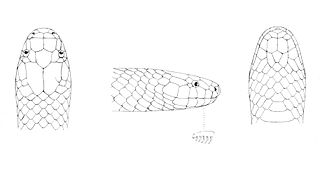
Dibamidae or blind skinks is a family of lizards characterized by their elongated cylindrical body and an apparent lack of limbs. Female dibamids are entirely limbless and the males retain small flap-like hind limbs, which they use to grip their partner during mating. They have a rigidly fused skull, lack pterygoid teeth and external ears. Their eyes are greatly reduced, and covered with a scale.

Skinks are lizards belonging to the family Scincidae, a family in the infraorder Scincomorpha. With more than 1,500 described species across 100 different taxonomic genera, the family Scincidae is one of the most diverse families of lizards. Skinks are characterized by their smaller legs in comparison to typical lizards and are found in different habitats except arctic and subarctic regions.

Miriam's skink is a skink, a lizard in the family Scincidae. The species is endemic to Thailand.

Eulamprus is a genus of lizards, commonly known as water skinks, in the subfamily Sphenomorphinae of the family Scincidae. The genus is native to Australia.
Glaphyromorphus is a genus of lizards in the skink family (Scincidae).

Lygosoma is a genus of lizards, commonly known as supple skinks or writhing skinks, which are members of the family Scincidae. Lygosoma is the type genus of the subfamily Lygosominae. The common name, writhing skinks, refers to the way these stubby-legged animals move, snake-like but more slowly and more awkwardly.
Edward Harrison Taylor was an American herpetologist from Missouri.

Marie Firmin Bocourt was a French zoologist and artist.

Axel Johann Einar Lönnberg was a Swedish zoologist and conservationist. Lönnberg was born in Stockholm. He was head of the Vertebrate Department of the Naturhistoriska Riksmuseet from 1904 to 1933.
Gyldenstolpe's worm skink, also known commonly as Gyldenstolpe's isopachys and Gyldenstolpe's snake skink, is a species of lizard in the family Scincidae. The species is endemic to Thailand.

Nils Carl Gustaf Fersen Gyldenstolpe was a Swedish explorer, zoologist, and ornithologist. Born in the central Swedish province of Jämtland, he visited Lapland from 1906 to 1909 and joined the expedition of Dr. Paul Rosenius to southern Algeria. He also visited Thailand in 1911–12 and the Malay Peninsula in 1914–15. He studied at Uppsala University and joined under Professor Einar Lönnberg at the Department of Vertebrates of the Naturhistoriska Riksmuseum in Stockholm. He continued to work here throughout his life. In 1924 he obtained a Ph.D. from Lund University for his studies on the birds of central and eastern Africa.

Toxicocalamus is a genus of snakes in the family Elapidae. The genus is endemic to New Guinea.

Emoia atrocostata, commonly known as the littoral whiptail-skink, mangrove skink, or littoral skink, is a species of lizard in the family Scincidae. It inhabits mangroves, back-beach vegetation and rocky shorelines. It is semi-aquatic and forages in tidal pools.
Herbert's supple skink, also known commonly as Herbert's writhing skink is a species of lizard in the subfamily Lygosominae of the family Scincidae. The species is native to Malaysia and Thailand.
Isopachys borealis, also known as Lang's isopachys, is a species of skink. It is found in Thailand and Myanmar. Isopachys borealis is limbless and fossorial, occurring in the moist topsoil of tuber and fruit plantations; its natural habitat preferences are poorly known.

Isopachys roulei, also known as the Chonburi snake skink, is a species of limbless skink. It is endemic to Thailand and known from Chonburi and Nakhon Ratchasima Provinces.










